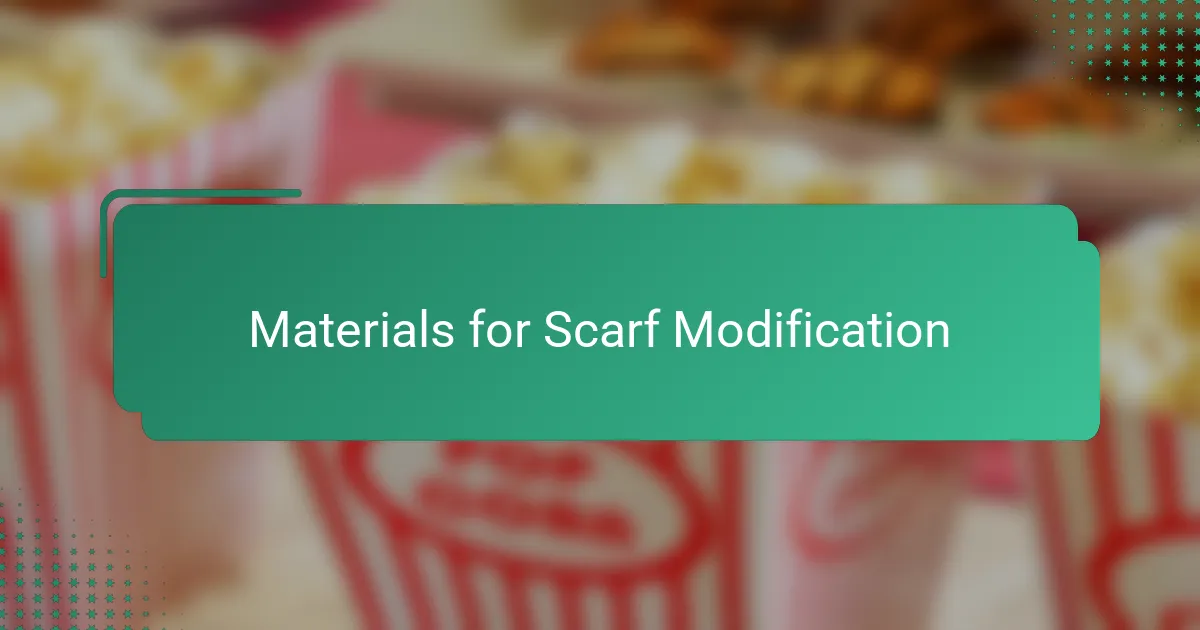Key takeaways
- Science fiction props evoke nostalgia and creativity, connecting fans to the stories and characters they love.
- Choosing the right prop, coupled with the proper tools, enhances the modification experience, allowing for personal expression while respecting the original design.
- Subtle material choices and techniques, such as careful stitching and use of stabilizers, play a crucial role in maintaining the integrity and design of modified props.
- Regular maintenance and gentle care for modified items ensure their longevity and preserve the connection to cherished fandoms.

Understanding Science Fiction Props
Science fiction props are more than just objects; they are bridges to other worlds. When I first held a recreated prop, I felt an immediate connection to the story it came from, almost as if I could sense the character’s presence. Isn’t it fascinating how a simple item can evoke such vivid imagination and nostalgia?
In my experience, understanding these props means appreciating the careful craftsmanship behind them. Every detail, from texture to color, is chosen to tell a story, grounding futuristic concepts in reality. Have you ever noticed how a well-made prop can make a fictional universe feel completely believable?
What truly intrigues me is how these objects evolve with the fans who interact with them. Modifying a prop, like adding personal touches or reimagining its look, isn’t just about customization—it’s a way to keep the story alive and make it your own. Have you ever felt that spark when your hands bring a piece of the sci-fi world to life?

Tools for Prop Modification
When I first decided to modify my Doctor Who scarf, I quickly realized how essential the right tools are to bring my vision to life. A sharp pair of fabric scissors was my go-to for clean cuts, while a fine needle and strong thread helped me add new stripes without unraveling the original knit. Have you ever caught yourself fumbling with the wrong tool and thought, “There must be a better way”?
I also found that a seam ripper became unexpectedly important—it saved me from a few frustrating moments when my stitches didn’t line up perfectly. Using a small measuring tape made all the difference too, ensuring each stripe was just right and the scarf’s proportions stayed true to its iconic look. Don’t you find the process smoother when everything is measured and deliberate?
Sometimes, I got creative with textile glue for quick fixes, especially when I wanted to add patches without sewing. It felt like a delicate dance between preserving the vintage vibe and making subtle improvements. Isn’t it amazing how the right tool can turn a simple alteration into a heartfelt homage to the original prop?

Choosing Your Prop to Modify
Choosing the right prop to modify is, in my experience, the foundation of a satisfying project. When I first picked up the Doctor Who scarf, I knew I wanted something iconic yet adaptable—something that felt personal but still honored the original design. Have you ever felt that pull toward a prop that seems to resonate with your own style or story?
I’ve noticed that selecting a prop with materials and construction you’re comfortable working with makes the whole process less intimidating. For me, the scarf’s knit fabric was familiar enough to handle, but it also presented challenges that made the project exciting—like balancing preservation with creativity. Isn’t it rewarding to tackle such challenges and see your effort breathe new life into a beloved piece?
Sometimes, it’s about the story the prop carries as much as its physical form. I often ask myself, does this item inspire me enough to invest hours into modification? That spark of enthusiasm keeps me motivated through meticulous work and small setbacks. Have you found that your connection to a prop shapes how much time and care you’re willing to pour into it?

Materials for Scarf Modification
When I gathered materials for modifying my Doctor Who scarf, fabric choice stood out as crucial. I opted for acrylic yarn that closely matched the original’s vibrant colors because it offered both durability and flexibility. Have you ever noticed how even a slight difference in texture or hue can change the entire feel of a prop?
Adding new stripes required selecting thread that wouldn’t fray easily but still blended seamlessly with the knit. I went with a strong polyester thread—its resilience surprised me and kept the stitches intact through multiple wearings. It made me wonder, how often do we overlook the strength behind simple materials in our crafting projects?
Besides yarn and thread, I found subtle tools like fabric stabilizers were lifesavers in maintaining the scarf’s shape during alteration. Without these, I’m convinced parts might have stretched oddly or lost their iconic drape. Isn’t it interesting how small, lesser-known materials can make or break a modification effort?

Step by Step Scarf Alteration
Taking the first step in altering the Doctor Who scarf was both exciting and a bit daunting. I began by carefully laying the scarf flat and marking where I wanted to add or adjust stripes—precision here felt key because even a small misalignment could throw off that classic look. Have you ever felt that delicate balance between being meticulous and wanting to just dive in?
Next came the cutting and stitching phase, which honestly tested my patience. Using my fabric scissors, I trimmed away parts with slow, deliberate snips, making sure not to damage the original knit. Sewing in new stripes required steady hands and lots of practice; I often paused, rethreaded my needle, and took a deep breath before continuing. Does that ring a bell—how certain crafts demand both focus and a bit of meditation?
Finally, I added finishing touches like securing loose threads and smoothing any puckered sections using gentle stretching techniques I’d learned from my previous projects. It felt like watching the scarf transform before my eyes, becoming something uniquely mine while still honoring the iconic style. Isn’t that the magic of prop modification—being both creator and caretaker?

Customizing Your Doctor Who Scarf
Customizing your Doctor Who scarf invites a blend of creativity and respect for the original design. When I added my own color variations to the stripes, I felt like I was weaving a personal story into the fabric—each new hue reflecting a bit of my own fandom and style. Have you ever experienced that thrill of making something uniquely yours while still nodding to the classic look?
I found that subtle changes, like adjusting the length or softening the edges, made the scarf more comfortable to wear without losing its iconic charm. It wasn’t just about aesthetics; it was about making the prop live and breathe in real life. Don’t you think that wearing a modified prop adds a new layer of connection to the character and story?
Sometimes, the best customizations come from happy accidents—like a slightly uneven stripe that suddenly gave the scarf a quirky, handmade feel. I learned to embrace imperfections as part of the charm, reminding me that these props are extensions of ourselves, not mass-produced items. Have you ever found beauty in the little mistakes that make a project feel truly authentic?

Tips for Maintaining Modified Props
Keeping your modified Doctor Who scarf in top shape means regular care, something I learned after noticing small snags from everyday wear. Have you ever caught yourself tugging too hard on a delicate seam? Gentle hand washing and avoiding harsh detergents can really preserve those hard-earned stripes and prevent color fading.
I’ve also found storing the scarf flat or loosely rolled helps maintain its shape and prevents stretching, especially around the areas I added new stitches. Isn’t it surprising how the way you put away a prop can affect its lifespan just as much as how you wear it? Treating your modified item like a treasured artifact keeps the magic alive.
Finally, I keep a small repair kit close—extra thread, a needle, and sometimes fabric glue—for quick fixes when tiny loose ends appear. Don’t underestimate the power of catching those little issues early; I’ve saved many beloved pieces from unraveling just by addressing problems as soon as they show up. Have you experienced that relief when a small repair saves a cherished prop from damage?


